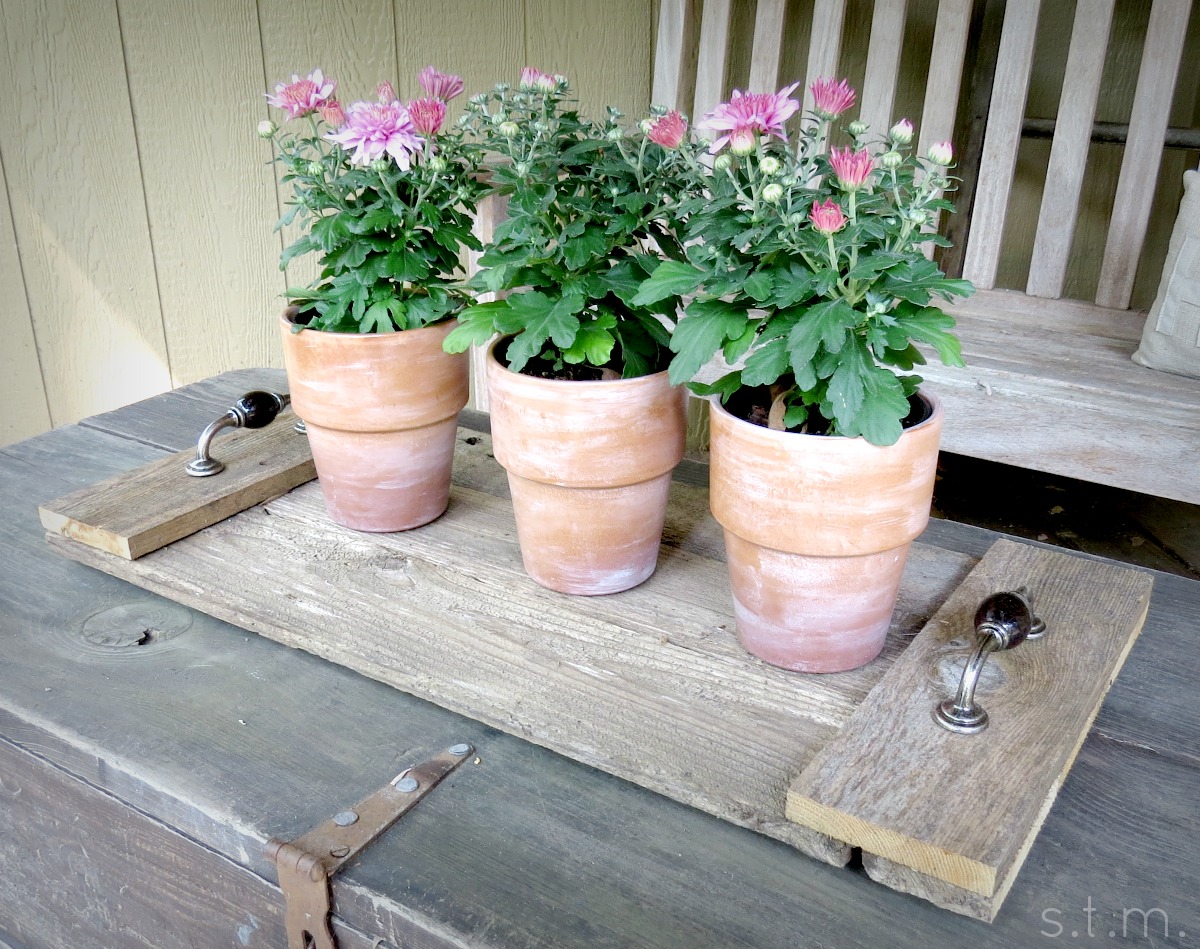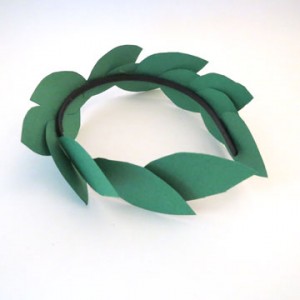I go to bed in mourning. We broke down our only child’s baby bed this afternoon and made way for “big boy” bunk beds. I’m telling you, I had to fight back the tears. . . but our son does seem to like his new sleeping quarters. On the bright side of things it does make reading to him before bed a bit easier, but I’m not sure I’m completely ready to trade the rocking chair for a double bunk and a book.

Laurel Wreaths Three Ways
Our Vacation Bible School theme this year is “Escape to Athens with Paul,” so all the children and adults have been donning togas and laurel wreaths for the week — nothing like getting into character. While a friend made the “fancy” wreaths for all the workers, it was just too expensive of a project for all the kids to create. So in the interest of sticking to a budget (it’s VBS after all), I came up with a couple of inexpensive wreath alternatives, one for the older children and another for the youngsters. I think the kids enjoyed making their own wreaths, but with the everyday use I have noticed a few stray leaves here and there.
We’ll start with the easiest and least expensive wreath and work our way up from there.
- construction paper
- glue sticks
- wrapping tape
Cut strips of construction paper 3/4 inch thick for the headband portion. Measure the circumference of each child’s head and trim accordingly, but don’t tape closed at this point. Cut out 14 leaves for the each wreath (I used a very simple leaf shape that I drew, because we literally cut out hundreds of these things). Using the glue stick, add the leaves to the band starting at the back and working forward. This works best if each new leaf is glued under the previous leaf, but our kiddos stuck them on every which way and they turned out really cute. Once all the leaves are glued on, use the wrapping tape to close the wreath loop and that’s it. Our four- and five-year-old kids made this type of laurel wreath, and even our older nursery children managed these with a little assistance.
- plastic headbands
- construction paper
- glue dots
I love the way these laurel wreaths turned out, and they look adorable placed backward on the head so that the leaves wrap toward the face — very authentic. Again, we used 14 leaves for each wreath and used gluedots to adhere them. For the best effect, start at the back and work toward the front, placing each new leaf under the previous one (or however your kids decide to do it). The first through sixth graders made this type of wreath, but the younger kids had a bit of trouble with the glue dots. By the way, I found cheap four-packs of headbands at the dollar store.
- medium gauge floral wire
- silk ivy vines
- green floral tape
We (okay, not me — thanks Morgan) made these wreaths for all the VBS workers to wear during our week in Athens. This project was not extremely expensive but I felt it was too much for our craft budget, thus the alternative wreaths #1 and #2 shown above.
Use your head as a general pattern to cut the lengths of floral wire and ivy vines. The finished product will just set on top of your head so the size doesn’t have to be exact. Twist the ends of the wire together to make a circle and wrap the ends with floral tape. Then wrap the wire loop with your ivy vine and adhere by wrapping both the wire and ivy vine together with the floral tape. That’s it — it’s super easy but can be a bit time consuming if you need to make several.
I hope you’ve found at least one of these ways to be suitable for making your own laurel wreaths, and good luck ”being Greek.”
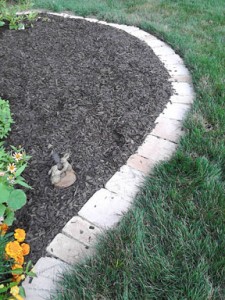
Build a Weed Wackless Flower Bed Border
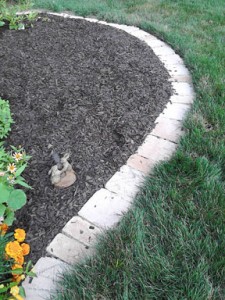 My husband confessed to me the other day that he just doesn’t think he is a yard person. Which I think is ironic since he has done nothing but baby our front yard ever since planting it last year. That being said, I think I understand what he means, so I decided to help him keep our front lawn looking nice and tidy without all the hours of weed wacking that comes with such a task.
My husband confessed to me the other day that he just doesn’t think he is a yard person. Which I think is ironic since he has done nothing but baby our front yard ever since planting it last year. That being said, I think I understand what he means, so I decided to help him keep our front lawn looking nice and tidy without all the hours of weed wacking that comes with such a task.
I don’t remember where I originally saw this idea, but I’m so glad I did. I just created a large flower bed along the front of the house using “stone” pavers, but I set them into the ground just a bit so that the wheels of the lawn mover roll right across the top, virtually eliminating the need to trim along the edge. (Yes, honey, you may thank me, again.)
The process is simple and I completed the installation by myself in about three hours. Here are the materials I used for this project:
- pavers
- shovel
- sand
- weed block matting
I chose imitation stone pavers from Home Depot in a variety of sizes to give it a less formal look. Make sure you buy pavers wide enough to allow your lawn mover blade to cut your grass along the outside edge. I laid out my pavers exactly like I wanted them and left them their for a couple of weeks until the grass under them died, but you don’t have to wait that long. It might make digging a bit more difficult, but it shouldn’t be too bad.

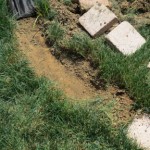 Working in small sections to keep the integrity of the border shape, I pulled up the placed pavers and laid them to the side (keeping their original order). With my shovel I dug a shallow trench the width of the pavers and the shape of the border. Make sure you only dig down far enough to make your pavers the same height as your lawn. I laid down the weed block mat and a shallow lining of sand to level out the trench. One by one, I replaced the pavers in order, using the sand to keep things level (you may have to add sand along the way). After I finished replacing all the pavers, I continued with the next section and so on.
Working in small sections to keep the integrity of the border shape, I pulled up the placed pavers and laid them to the side (keeping their original order). With my shovel I dug a shallow trench the width of the pavers and the shape of the border. Make sure you only dig down far enough to make your pavers the same height as your lawn. I laid down the weed block mat and a shallow lining of sand to level out the trench. One by one, I replaced the pavers in order, using the sand to keep things level (you may have to add sand along the way). After I finished replacing all the pavers, I continued with the next section and so on.
After all the pavers were placed, I back filled (behind the black matting) any necessary spots with dirt and filled the gaps between the pavers with sand. I gave everything a good watering and voila! It really was a simple project that makes it so much easier to maintain a crisp flower bed edge. Unfortunately it’s too hot to finish planting that beautiful space I just created, but it’s ready for just the right day.
Shared with:The Scoop @ Cedar Hill Ranch
Wow Us Wednesdays @ Savvy Southern Style




